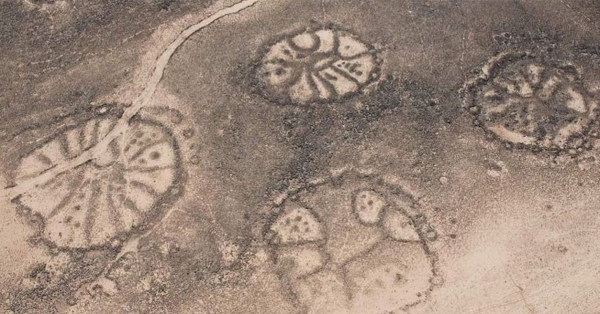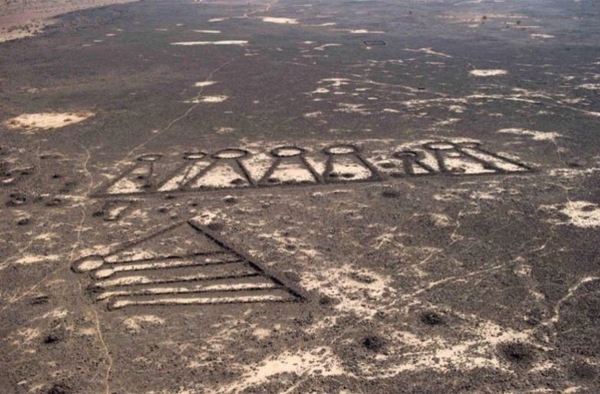


The Stone Structures in the Kingdom of Saudi Arabia are stone archaeological landmarks built by ancient civilizations that succeeded each other over various ages on the land of the Kingdom. These stone structures, in their various forms, are important indicators of the historical depth of the Kingdom's land and the level of civilizational development of the successive nations that lived in the region. They are architectural testimonies of buildings with diverse shapes, functions, and historical periods, most of which have been documented by satellite images. These structures are scattered throughout the Kingdom, especially in volcanic Harrat areas, near oases, and ancient civilization centers, forming clusters that extend for tens of km.
The concept of stone structures
The Antiquities, Museums, and Urban Heritage Law, issued by Royal Decree in 2014, defines stone structures as Antiquities related to land, such as natural or human-excavated caves, rock drawings, rock carvings, rock engravings, rock inscriptions, stone piles, stone circles, urban and rural ruins, prominent or buried structures, water structures, ancient pilgrimage and trade routes, traditional cities, villages and neighborhoods, buildings constructed for various purposes as well as their ruins, and any related architectural elements.
History of archaeological stone structures in the Kingdom
The Kingdom is rich in historical evidence of human architecture throughout its history, with stone structures widespread in most of its regions. Their earliest appearance dates back to the third millennium BCE, serving as fixed structures associated with semi-settled and interrelated population groups.
The roots of these structures date back to prehistoric civilizations and ages, with the oldest archaeological finds in these sites dating to the Chalcolithic (Copper) Age. They disappeared after the first half of the Early Middle Bronze Age, around 1850 BCE. The precise reasons why those stone structures were used are still unknown. Perhaps some of these structures were used as accommodation, while others were used for funeral burials as in tapered facilities (those which have what looks like tails).
The importance of archaeological stone structures in the Kingdom
Despite being exposed to various climatic factors that affect their preservation, stone structures serve as natural museums shedding light on the history of ancient civilizations that inhabited the Arabian Peninsula. Their number reaches 868 sites, some of which date back to the seventh millennium BCE.
There are several interpretations regarding the functions and uses of stone structures, all falling under categories defined by scholars. Some interpreted them as tombs, while others saw them used for geographical orientation and caravan route indicators. Some believe they were used as desert traps, while others suggest they served as walls for agricultural or residential holdings, or as ancient animal enclosures.
The archeological categorizations of these stone structures, which amount to ten, vary regardless of their functions and uses. These are stone circles, stone fences, cumulus monuments, tapered stone facilities, basins, stone buildings in the shape of "traps", hill cemeteries, platforms, columns, and early Iron Age cemeteries.
Stone cemeteries in the Kingdom
Archaeological studies indicate that stone structures used as tombs date back to the pre-Islamic period, with the majority dating to the Bronze Age. Their forms vary according to the time period, geographical region, and culture. Some tombs come without appendages, such as the multiple-tiered rubble, tumulus, tower-shaped, and mounds, while others have appendages like enclosures, triangles, rectangles, serrations, and keys.
These tombs appeared across multiple eras, including the Neolithic, Bronze, Iron, Classical, and Roman periods, characterized by their diverse geometric formations. Examples include the stone structure discovered near Uqaylah al-Misha'an in Sikaka, as well as in al-Jawf province.
Stone trap structures in the Kingdom
As for the stone structures shaped like traps, they consist of two parts: long and low walls that converge to form a containment shape called the head, often taking the form of a circle surrounded by small circles representing excavations. Some of these walls extend for more than five km, while the diameter of the head sometimes exceeds one hundred m.
This type of stone structure spread from Yemen in the south to Armenia in the north and central Asia. 5,809 traps have been documented, 868 of which are in the Kingdom and they date back to the seventh millennium BCE.
Archaeological stone circles in the Kingdom
In the stone circle group in the Kingdom, it is evident that they take on a circular or semi-circular shape, in various forms, including complex groupings, circles without internal divisions, circles with internal divisions, and complex circles. These stone circles are distributed throughout the Kingdom and date back to different periods depending on their purpose.
Archeological rectangle structures in the Kingdom
Rectangular structures or "gateways" were built for the purpose of practicing religious and social rituals. They take on a rectangular shape, with some exceeding lengths of five hundred m. These stone structures are scattered from the Harrat Khaybar area in the northeast to the north of Hail City, dating back to the Neolithic period.
The extending archeological walls
Within the stone structure groups, there's also the category of extended walls, which are stone walls extending from the mountaintop to the foothills and across flat terrain. Their uses have not yet been firmly established, but they were likely used as tombs or barriers. They are scattered in various provinces of the Kingdom, and the period of these discoveries remains unknown.
The erected archaeological columns
The group of columns takes on the description of being erected, with archaeologists believing they were erected by humans in a period dating back thousands of years before the common era. Their shapes vary, such as extended standing stones, opposing standing stones, and triliths. Scientists have suggested, without certainty, that they may be tombs for vanished people, while others see them as symbols with astronomical significance.
Sites of archaeological stone structures
Through archaeological research and excavation, several sites containing stone structures have been discovered in various provinces of the Kingdom, such as tombs in the southern Dhahran area, tombs in al-Kharj Governorate and Wadi ad-Dawasir, the site of Rajm Sa'asa in Tayma' Governorate, and Wadi Sharmah in Tabuk Province.
In general, all provinces of the Kingdom contain stone structures, especially in volcanic areas, near oases, and ancient civilization centers. These structures form in clusters stretching for tens of km, as seen in the archaeological stone structures surrounding the village of Zabaran in Khaybar Governorate, al-Madinah al-Munawwarah Province. The area of Khaybar falls within the scope of Harrat Khaybar, hence it contains numerous stone structures.
Archaeological stone structures in an-Nufud Desert
In 2020, a scientific team discovered stone structures in an-Nufud Desert, consisting of animal traps considered to be among the oldest stone traps in the world, dating back more than seven thousand years.
These discoveries confirm the continuous cultural succession in the Kingdom's territories throughout history, indicating that the northern regions of the Kingdom witnessed a civilization's development around five thousand years ago. This is evidenced by the construction of massive complexes containing hundreds of large stone structures.
Excavations and research have identified 104 stone structures around the southern fringes of an-Nufud Desert, indicating their dispersion far from Harrat Khaybar. According to studies, the relative chronological sequence of the rectangular structures revealed a correlation between the study's results and previous studies in the Kingdom. These structures have been dated from five thousand to two thousand years BCE.
Documenting archaeological stone structures in the Kingdom
The Heritage Commission, affiliated with the Ministry of Culture, launched a scientific project in 2021 to document and study stone structures in the Kingdom, in collaboration with relevant national and international institutions and centers, as part of the survey and excavation program of the Heritage Commission.
This project is part of a series of efforts aimed at preserving Saudi antiquities, representing one of the most significant archaeological research projects in the coming years. It involves building a long-term strategy, developed and implemented by qualified national personnel, to enrich the Kingdom's historical heritage with valuable information and fruitful results. The project aims to cover all archaeological sites and to document approximately five hundred thousand sites for study and analysis.
Hima cultural area in Najran
The Hima Cultural Area in Najran was inscribed in 2021 on the United Nations Educational, Scientific, and Cultural Organization (UNESCO) World Heritage List as a cultural site of outstanding universal value for human heritage.
This region is rich in a diverse stone heritage with arts and inscriptions that reflect written, artistic, historical, and even ethnographic documentation of climate change events during the prevailing period. This is evident through the extensive archaeological remains found at the Hima site in the form of structures, installations, and tumulus graves, as well as workshops for manufacturing stone tools such as axes, pestles, and stone arrowheads, in addition to ancient wells that are still in use today.
Stone constructions in al-Dhulayat Mountain in al-Jawf
A team of Saudi and international archaeologists discovered one of the oldest stone structures built by humans in al-Dhulayat Mountain in al-Jawf Province, located in the northern part of the Kingdom. Its origins date back to a period between eight thousand and nine thousand years before the present time. These findings emerged as part of archaeological survey projects conducted recently by the Heritage Commission in collaboration with international scientific centers.
On May 17, 2023, the journal "PLOS One" published a scientific paper about these stone structures, which, according to the paper, represent stone traps. These are large-sized structures used as traps for animals, dating back to prehistoric times, reflecting ancient humans' ability to adapt to the environment by transferring a large area into a small two-dimensional surface. They signify a remarkable milestone in human intelligent behavior and enhance understanding of how desert stone traps were conceptualized and constructed. These stone traps were first observed from airplanes in the 1920s, according to the scientific paper. Initially, they were perceived as sophisticated archaeological structures consisting of walls and stone forms extending for over five km, converging in a large area, and connected to smaller rooms, especially in the outer corners and angles. However, their function and use as traps for wild animals, as well as their dating, were not confirmed until recent years, with the discovery of more than six thousand such structures to date.
In al-Dhulayat Mountain, two pairs of desert stone traps were found, spaced about 3.50 km apart. Additionally, a small panel depicting a desert stone trap was discovered in this area, drawn on a stone measuring 382 cm in length and 235 cm in width, dating back to around eight thousand years ago. Other miniature structures of these massive buildings have been previously found in the area, but they did not exhibit the same level of precision as those found in al-Dhulayat.
Related quizzes
Related articles

